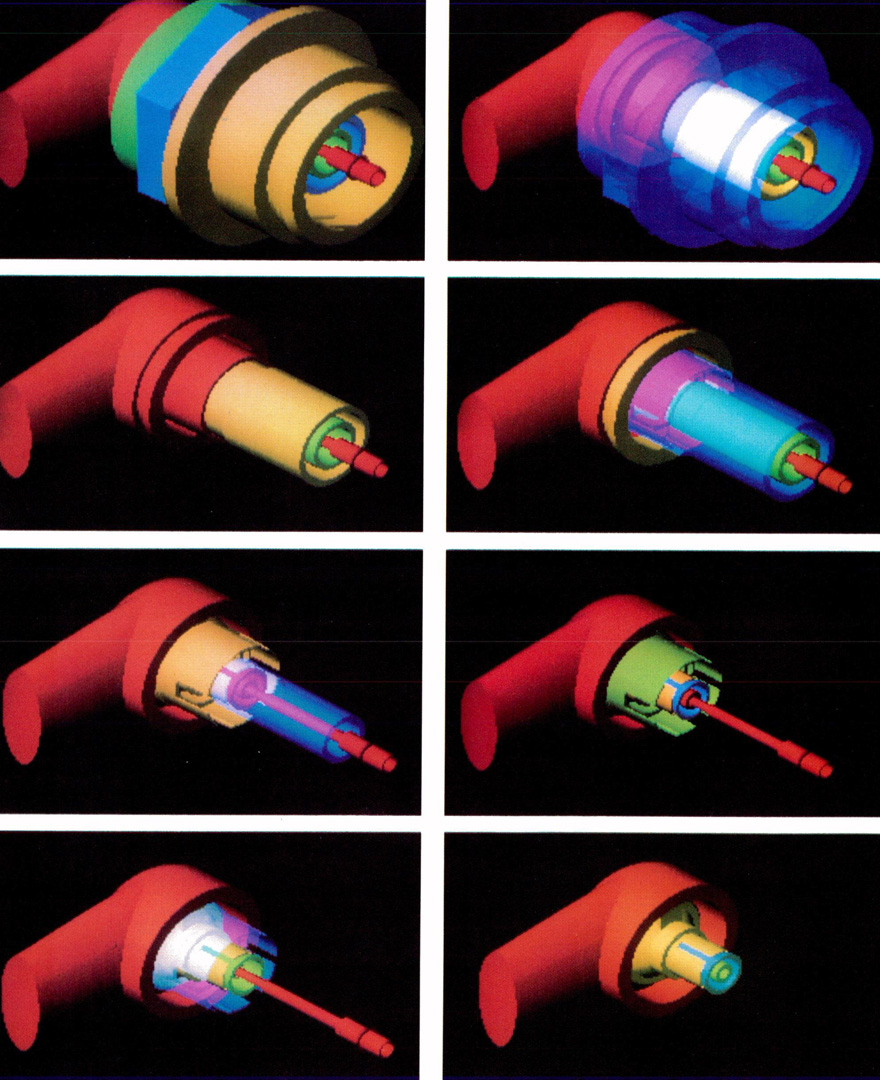“A method of interactive visualization of CAD surface models on a color video display” by Atherton
Conference:
Type(s):
Title:
- A method of interactive visualization of CAD surface models on a color video display
Presenter(s)/Author(s):
Abstract:
To introduce rendered surface display technology into the production design environment, many CAD operations envision a single color video display device for download processing of selected model pictures. Creation of a single image from a typical industrial CAD model involving a large number of higher order curved surfaces will normally require a minimum of several minutes’ delay for data acquisition and visible surface computation. This paper describes a method that extends the visible surface operation to give the designer an interactive tool with which he can more effectively comprehend model composition. Instead of defining data for a single image, an intermediate three-dimensional structured file is created. A tailored display program manipulates the structured data file allowing a user to interactively create surface rendered images. Program capabilities include: • Section and cutaway viewing • Selected surface color, transparency, or translucency • Shadows projected from desired light-source locations Changing or combining any of these facilities requires only seconds for a new image to be created.
References:
1. Appel, A., “The Notion of Quantitative Invisibility and the Machine Rendering of Solids,” Proceedings ACM, 1967 National Conference.
2. Artzy, E., Frieder, G., and Herman, G.T., “The Theory, Design, Implementation and Evaluation of a Three-Dimensional Surface Detection Algorithm,” SIGGRAPH 1980 Proceedings.
3. Bouknight, W.J., and Kelley, K.C., “An Algorithm for Producing Half-Tone Computer Graphics Presentations with Shadows and Movable Light Sources,” SJCC, AFIPS, Vol. 36, 1970.
4. Csuri, C., Hackathorn, R., Parent, R., Carlson, W., and Howard, M., “Towards an Interactive High Visual Complexity Animation System,” SIGGRAPH 1979 Proceedings.
5. Dyer, C.R., Rosenfeld, A., and Samet, H., “Region Representation: Quadtrees from Binary Codes,” CACM, June 1980.
6. Fuchs, H., Clark, J., Cohen, D., Newell, M., Parke, F., and Sproull, B., “Trends in High Performance Graphics Systems,” SIGGRAPH 1980 Conference Panel.
7. Goldstein, R. and Nagel, R., “3-D Visual Simulation,” Simulation, January 1971.
8. Hinds, J.K., Kuan, L.P., “Sculptured Surface Technology as a Unified Approach to Geometric Definition,” Computer and Automation Systems Association of the Society of Manufacturing Engineers, 1979.
9. Kay, D.S., “Transparency, Refraction and Ray Tracing for Computer Synthesized Images,” M.S. Thesis, Cornell University, January 1979.
10. Nagel, R.N., Braithwaite, W.W., and Kennicott, P.R., “Initial Graphics Exchange Specification IGES Version 1.0,” National Bureau of Standards, January 1980.
11. Newell, M., Newell, R., and Sancha, T., “A New Approach to the Shaded Picture Problem,” Proceedings ACM, 1972 National Conference.
12. Rhodes, M.L., “An Algorithmic Approach to Controlling Search in Three-Dimensional Image Data,” SIGGRAPH 1979 Proceedings.
13. Romney, G., Watkins, G., and Evans, D., “A Real Time Display of Computer Generated Half-Tone Perspective Pictures,” IFIP 1968, Amsterdam, North-Holland, p. 973.
14. Samet, H., “Region Representation: Quadtrees from Binary Codes,” CACM, March 1980.
15. Watkins, G., “A Real-Time Visible Surface Algorithm,” Computer Science Department, University of Utah, UTECH-CSC-70-101, 1970.
16. Whitted, J.T., “An Improved Illumination Model for Shaded Display,” CACM, June 1980.




